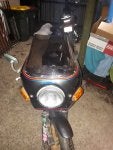I bought one of the first 500 Pantahs in Britain, as it was my dream bike, a 90 deg vee-twin version of the 250 Ducati. It was light, handled great and was blistering fast, revving like a two-stroke. I had great fun on it for six months, thrashing it everywhere and giant-killing bikes twice the size (I was young) but there was one drawback: I couldn't stand the snatchy transmission. Every time the throttle was opened and closed, or feathered, it would clonk back and forth, and to avoid this the engine had to be kept revving and it had to be ridden fast. Compared to my fantastic 750 Sport it was a PITA, so it had to go. Every belt camshaft Ducati that I have owned has been like this, which is why they have all never lasted long in my ownership.
Many will disagree with this, but I blame Franco Farne, who while testing the Pantah found that due to the 90 deg crankshaft, the flywheels could be made much lighter, to help the engine rev. I think that a vee-twin, due to the uneven firing intervals, needs heavy flywheels to stop transmission snatch, otherwise the revs need to be kept up, which to my mind defeats the purpose of a vee-twin, which is a torquey, thunderous engine. To each his own!







